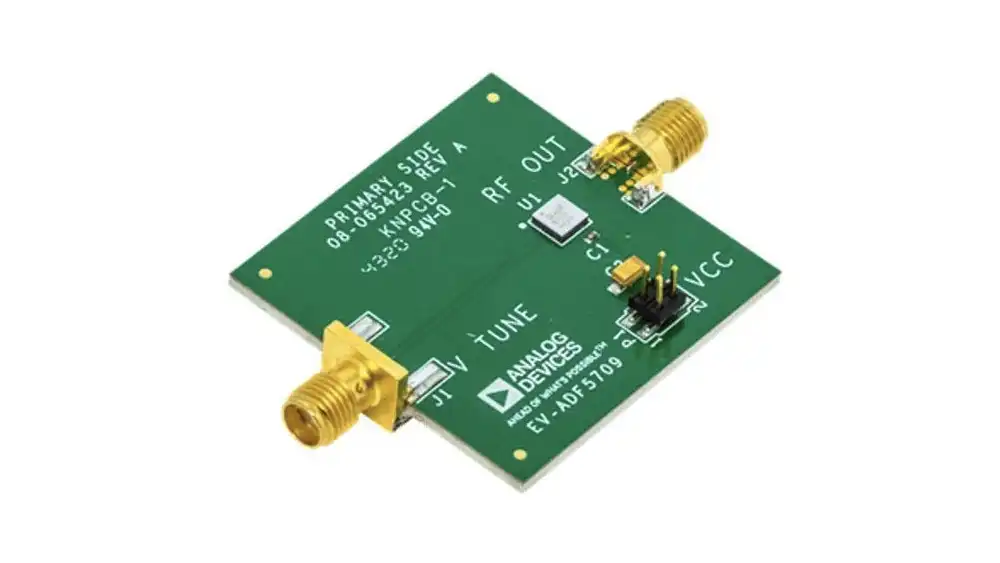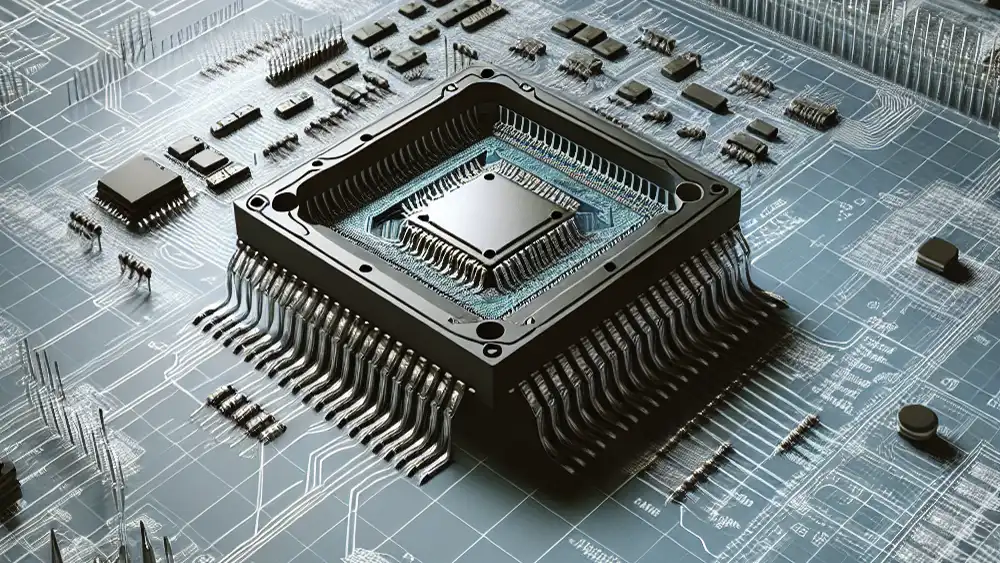In the modern world of electronics, the monolithic integrated circuit (IC) stands as a cornerstone of technological innovation. It represents a pivotal advancement in miniaturization and functionality, enabling the seamless integration of complex electronic circuits on a single semiconductor substrate.
What is an Integrated Circuit (IC)?
An integrated circuit, commonly known as an IC or microchip, is a miniature electronic circuit consisting of semiconductor devices and passive components (such as resistors, capacitors) fabricated on a single piece of semiconductor material.
Evolution of Monolithic Integrated Circuits
The concept of integrating multiple electronic components onto a single substrate traces back to the mid-20th century, evolving from discrete transistor circuits to highly integrated monolithic ICs.
Monolithic Microwave Integrated Circuit

A Monolithic Microwave Integrated Circuit (MMIC) is a specialized electronic device designed to work with microwave frequencies, which range from 300 million cycles per second (MHz) to 300 billion cycles per second (GHz). These circuits are built using semiconductor materials like gallium arsenide (GaAs) or indium phosphide (InP).
What makes MMICs unique is their ability to pack a variety of active and passive components onto a single chip. Active components include devices that can amplify signals or generate oscillations (like amplifiers and oscillators), while passive components can perform functions like mixing signals or shifting their phase (like mixers and phase shifters).
MMICs are crucial in applications where operating at high frequencies and maintaining compact size are important. For instance, they play a key role in radar systems, enabling the transmission and reception of microwave signals for detecting objects or measuring distances. In satellite communications, MMICs help in processing signals efficiently as they travel through space. They are also integral to the operation of wireless networks, ensuring that signals can be transmitted and received reliably across various devices.
MMICs represent a sophisticated integration of technology that enables advanced communication, sensing, and networking capabilities across a wide range of modern electronic devices and systems.
Monolithic Integrated Circuit Design
The design of monolithic integrated circuits involves meticulous planning and execution to achieve compactness, reliability, and optimal performance.
Basics of Monolithic IC Design
At its core, monolithic IC design revolves around laying out various electronic components—transistors, diodes, resistors, and capacitors—on a semiconductor wafer in a structured and interconnected manner.
Key Components of a Monolithic Integrated Circuit
Each monolithic IC typically comprises active components (like transistors for amplification or switching) and passive components (such as resistors and capacitors) integrated into a unified circuit design.
Fabrication Process of Monolithic Integrated Circuits
The fabrication process of monolithic ICs is a complex sequence involving several intricate steps to build the integrated circuit structure on a semiconductor substrate.
Step-by-Step Fabrication Process
Semiconductor Substrate Preparation
The process begins with a clean semiconductor wafer typically made of silicon, which serves as the foundation for the integrated circuit.
Layer Deposition
Thin layers of materials, including silicon dioxide and silicon nitride, are deposited onto the wafer to form the necessary insulating and protective layers.
Lithography
Using photolithography techniques, intricate patterns of the circuit components are transferred onto the wafer through light exposure and chemical etching processes.
Etching
Unwanted portions of the deposited layers are etched away, leaving behind the desired pattern of the circuit components on the wafer.
Doping
Doping processes introduce impurities into specific regions of the semiconductor to alter its electrical properties, crucial for creating transistors and other active components.
Metallization
Metal layers are deposited and patterned to interconnect the various circuit components, forming conductive pathways that enable electrical signals to flow between them.
Monolithic Integrated Circuit Technology

Monolithic Integrated Circuit Technology refers to the method of fabricating integrated circuits (ICs) on a single semiconductor substrate, typically made of silicon. This technology allows for the integration of a large number of electronic components such as transistors, resistors, capacitors, and diodes onto a single piece of semiconductor material.
The process starts with a blank silicon wafer onto which various layers of materials are deposited or implanted using advanced manufacturing techniques. These layers are then patterned and etched using photolithography and other processes to create the intricate circuitry that forms the basis of the integrated circuit.
Monolithic integration offers several advantages:
- Compact Size: By integrating multiple components onto a single chip, monolithic ICs can achieve high functionality in a very small space. This compactness is crucial for modern electronic devices where miniaturization is important.
- Performance: Monolithic IC technology allows for precise control over component parameters and electrical characteristics, leading to improved performance in terms of speed, power consumption, and reliability.
- Cost Efficiency: Mass production of monolithic ICs using semiconductor fabrication techniques allows for economies of scale, making these devices cost-effective compared to discrete components.
- Reliability: Integration reduces the number of external connections, which minimizes the risk of signal interference, noise, and other reliability issues that can arise in systems with many discrete components.
Monolithic Integrated Circuit Technology is fundamental to the electronics industry, enabling the development of a wide range of devices including microprocessors, memory chips, sensors, and communication ICs. Its continuous advancement has been a driving force behind the rapid progress in computing power, telecommunications, and consumer electronics over the past several decades.
Types of Monolithic Integrated Circuits
Monolithic ICs come in various types tailored to different applications, ranging from simple digital circuits to highly specialized analog and mixed-signal circuits.
Analog vs. Digital Monolithic ICs
Analog monolithic ICs process continuous signals, crucial for applications like audio amplifiers and sensors, whereas digital ICs manipulate discrete binary signals essential for computing and data processing.
Application-Specific Integrated Circuits (ASICs)
ASICs are customized monolithic ICs designed to perform specific tasks efficiently, offering tailored solutions for industries such as telecommunications, automotive, and consumer electronics.
Examples of ASICs in Various Industries
- Telecommunications: ASICs used in network switches and wireless communication devices.
- Automotive Industry: ASICs integrated into automotive control systems for enhanced safety and performance.
- Consumer Electronics: ASICs powering smartphones, digital cameras, and smart home devices.
Advantages of Monolithic Integrated Circuits
The adoption of monolithic IC technology has brought about significant advantages over traditional discrete component circuits.
Size and Weight Reduction
By integrating multiple functions into a single chip, monolithic ICs drastically reduce the size and weight of electronic devices, promoting portability and compact design.
Power Efficiency
Monolithic ICs consume less power compared to discrete circuits, contributing to extended battery life in portable devices and energy-efficient applications.
Cost Effectiveness
Mass production techniques and economies of scale make monolithic ICs cost-effective, lowering the overall manufacturing costs and making advanced technology more accessible.
Applications of Monolithic Integrated Circuits
Monolithic ICs find widespread application across various industries and technological domains, driving innovation and enhancing functionality in electronic devices.
Consumer Electronics
From smartphones to digital cameras, monolithic ICs power the core functionalities of modern consumer electronics, enabling advanced features and seamless connectivity.
Telecommunications
In telecommunications infrastructure, monolithic ICs play a crucial role in signal processing, data transmission, and network management, supporting the rapid expansion of global communication networks.
Automotive Industry
Automotive manufacturers leverage monolithic ICs for vehicle control systems, safety features, and in-car entertainment, enhancing vehicle performance, efficiency, and driver comfort.
Medical Devices
Monolithic ICs enable the development of sophisticated medical devices and equipment, facilitating precise diagnostics, therapeutic treatments, and patient monitoring systems.
Conclusion
Monolithic integrated circuits represent a pinnacle of technological achievement, transforming the landscape of electronics with their compact design, multifunctionality, and reliability. As the demand for smaller, more powerful electronic devices grows, the role of monolithic ICs in driving innovation across industries will continue to expand.